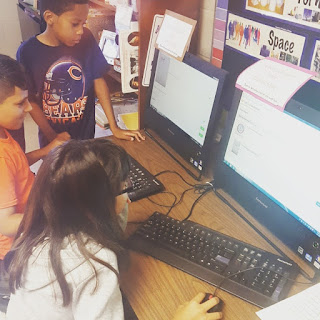So your students are in the middle of a project, but some of them are starting to approach you with their completed artworks. There are quite a few options you have for your early finishers until the entire class completes their own masterpieces and help pace your quick finishers.
Encourage students to
enhance their pieces. If your
students followed all the objectives and finished far ahead, consider
encouraging your student to add more.
Sometimes those extra finishing touches can make your student’s piece
stand out! With teaching in a K-6
school, I encourage students in every grade level to add a little more detail to
make their artworks pop. This is also a
good opportunity to do a formative assessment with your students to help them
see their work from different perspectives.
Use this time for
students to write artist statements or self reflections. Since our school uses Artsonia, I have
students include an artist statement along with their artworks. I start small with 1st grade by
having the students fill in a sentence, such as “My art project makes me feel…”
and the students fill in the rest. We
progress each year from one sentence, and by 6th grade, they write
up to a paragraph. There are many
options to writing their reflections and statements. If you use Artsonia, consider adding a place
for their statement to their grade sheet, which can be typed into the computer
at a later date, or if you have access to tablets, have students add their
statements directly to the app. You can
also use Google Classroom with the intermediate grade levels, which makes it
easy to copy and paste artist statements into Artsonia.
Create or find worksheets
related to the project. This also
works as a good wrap up to a unit! For
many of my projects, I utilize worksheets to help build upon the objectives of
the lesson. For example, After doing a
Joan Miro-inspired project, I can use a worksheet called “create a Miro” for
students to work with on their own. I
especially use this with the 6th grade level since they often finish
at different times throughout the lesson.
Another example can be having students create their own names in
hieroglyphs after creating an Ancient Egyptian-inspired project.
Create a resource center. A resource center provides additional
materials for students to use independently until all the students have
completed their work. Your resource
center can be as small as a bin on your cart, or as large as a shelving unit in
your room. In my room, I have an art library shelving
unit filled with many options for students to use once they have finished with
everything listed above. Your resource
center can hold many of the items listed:
Coloring pages are
not just for the kindergarteners! Even though I encourage the kindergarteners
to practice coloring in the lines, all grade levels enjoy time to just color
without worry. With the new adult
coloring book craze, students in the upper grade levels are enjoying more
advanced coloring pages to fill their time.
Blank paper is
always good to have on hand. There will
always be a handful of students to want to use the time to practice their own
drawing skills, and what better way to help inspire them to use “How to Draw” books. My students are always borrowing drawing
books for everything, but because they’re so popular, I never let them leave
the room. Students use the drawing books
for projects, art contests, and practicing on their own!
Scrap paper is
another resource to have on hand since many kids enjoy making their own collages. After trimming down paper for project sizes,
I always have a pile of multicolor scraps that students love to use. And if you teach them paper sculpture? Your scrap bin will empty out faster than you
know!
Art games can be
fun and educational, without disturbing other students to are completing their
artworks. I have a bin in the art
library containing games that students can play with two or more people, such
as Art Lingo (a visual bingo that helps students with their art vocabulary),
Hue Knew! (to help students match colors), Tangoes shape puzzles, and art
puzzles. The games are labeled in
baggies for easy clean up with the art class is finished.
Art-inspired books
are also a good resource to have in your stash.
This year’s favorite was “The Day the Crayons Quit” and Peter Reynold’s
“Creatology” trilogy! Students love to
borrow books from the art library, and many times, I catch them creating their
own artworks inspired by the books they read!
Throughout the year,
you will find many resources to help you balance your time with your early
finishers and last-minute crunchers.
Find what works best for you!





